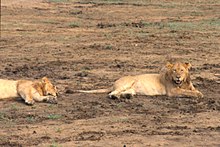Congo lion
| Congo lion | |
|---|---|

| |
| Male in Murchison Falls | |

| |
| Female in Murchison Falls | |
| Scientific classification | |
| Kingdom: | |
| Phylum: | |
| Class: | |
| Order: | |
| Family: | |
| Genus: | |
| Species: | |
| Subspecies: | P. l. azandica
|
| Trinomial name | |
| Panthera leo azandica | |
The Congo lion or Northeast Congo lion (Panthera leo azandica), also known as Uganda lion, was proposed as a lion subspecies from northeastern D.R. Congo and western parts of Uganda.[2]
Taxonomic history

In 1924, the American zoologist Allen proposed the trinomen Leo leo azandicus, and described a male lion as type specimen that was obtained by the American Museum of Natural History. This individual was killed in 1912 by museum staff as part of a zoological collection comprising 588 carnivore specimens. Allen admitted a close relationship to L. l. massaicus regarding cranial and dental characteristics but argued that his type specimen differed in pelage coloration.[3]
The British taxonomist Pocock subordinated lions to the genus Panthera in 1930 when he wrote about Asian lions.[4] Three decades later, Ellerman and Morrison-Scott recognized just two lion subspecies, namely the Asiatic P. l. persica and the African P. l. leo.[5]
Distribution and population status

In the Congo River basin, the Virunga National Park in the Democratic Republic of the Congo and the adjacent Queen Elizabeth National Park in Uganda may be a potential stronghold for lions in Central Africa, if poaching is curbed and prey species recover.[6]
Lions are also present in Uganda's Kidepo Valley and Murchison Falls National Parks, in the Central African Republic, in Rwanda's Akagera National Park and in the south of Sudan.[7]
In 2008, surveys were conducted in the Upemba and Kundelungu National Parks located in the Democratic Republic of the Congo, but no evidence of lion presence was found. There is a single Lion Conservation Unit in the Republic of the Congo, viz the Odzala National Park, where since 1995 no sign of lion presence was detected during surveys. In Gabon, lions may be extirpated as well.[8]
Conservation status
Since 1996, African lion populations have been assessed as Vulnerable by IUCN. They are killed pre-emptively or in retaliation for preying on livestock, and are threatened by depletion of prey base, loss and conversion of habitat. To address these threats, lion-human conflict needs to be reduced, and lion habitat and prey base increased.[9]
No captive individual of the Congo lion population is registered in the International Species Information System.[10]
See also
References
- ^ Wozencraft, W. C. (2005). "Order Carnivora". In Wilson, D. E.; Reeder, D. M. (eds.). Mammal Species of the World: A Taxonomic and Geographic Reference (3rd ed.). Johns Hopkins University Press. p. 546. ISBN 978-0-8018-8221-0. OCLC 62265494.
- ^ Allen, G. M. (1939). A Checklist of African Mammals. Bulletin of the Museum of Comparative Zoology at Harvard College 83: 1–763.
- ^ Allen, J. A. (1924). Carnivora Collected By The American Museum Congo Expedition. Bulletin of the American Museum of Natural History 47: 73–281.
- ^ Pocock, R. I. (1930). The lions of Asia. Journal of the Bombay Natural Historical Society 34: 638–665.
- ^ Ellerman, J. R., and T. C. S. Morrison-Scott. (1966). Checklist of Palaearctic and Indian Mammals 1758 to 1946. Second edition. British Museum (Natural History), London.
- ^ Treves, A., Plumptre, A. J., Hunter, L. T., & Ziwa, J. (2009). Identifying a potential lion Panthera leo stronghold in Queen Elizabeth National Park, Uganda, and Parc National Des Virunga, Democratic Republic of Congo. Oryx 43 (01): 60–66.
- ^ Bauer, H., Van Der Merwe, S. (2004). Inventory of free-ranging lions Panthera leo in Africa. Oryx 38 (01): 26–31.
- ^ Henschel, P., Azani, D., Burton, C., Malanda, G., Saidu, Y., Sam, M., Hunter, L. (2010). Lion status updates from five range countries in West and Central Africa. Cat News 52: 34–39.
- ^ Template:IUCN
- ^ Barnett, R., Yamaguchi, N., Barnes, I., Cooper, A. (2006). The origin, current diversity and future conservation of the modern lion (Panthera leo). Proceedings of the Royal Society B 273 (1598): 2119–2125. doi:10.1098/rspb.2006.3555 PMID 16901830
